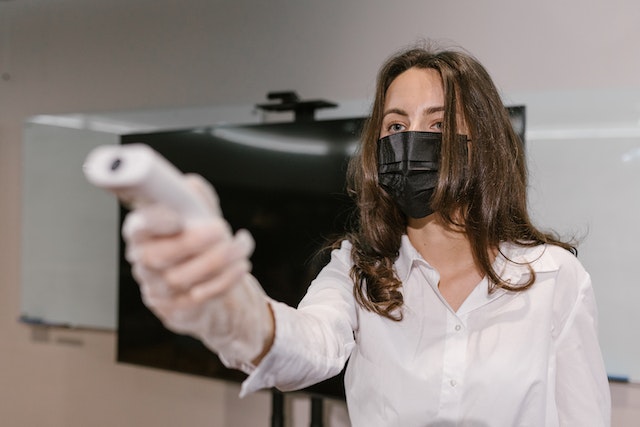Healthcare providers can monitor and analyze their patients’ health remotely by using remote patient monitoring devices. This allows them to keep tabs on their patients’ health conditions in real-time without the patients having to visit a clinic or hospital for a checkup. Should a patient’s condition deteriorate, the healthcare provider will receive an alert, allowing them to quickly take proactive measures to ensure the patient’s well-being.
Remote patient monitoring devices not only benefit clinicians, but also allow patients to be actively involved in monitoring their health conditions, giving them a clearer understanding and more control over their own health.
There are a wide range of devices that can be used to monitor a patient’s health remotely. Some of the more commonly used remote patient monitoring devices are listed below.
1. Bluetooth Thermometer
As elevated body temperature or fever can be a good indicator of poor health, a thermometer is an essential item in any first aid kit. A Bluetooth thermometer—either a non-contact digital heat-detecting thermometer that can be used to scan the forehead or a contact thermometer placed under the patient’s tongue—will not only accurately record a patient’s body temperature, but can also transmit the information to a remotely located healthcare provider for assessment so that they can take the necessary measures to reduce a patient’s temperature when necessary.
2. Blood Pressure Monitor
A Bluetooth-enabled blood pressure cuff is a device that is used to monitor a patient’s blood pressure and heart rate remotely, transmitting the information to the clinician in real-time. Monitoring blood pressure closely can help clinicians and their patients to manage hypertension and other diseases associated with high blood pressure on a day-to-day basis, giving an updated report of the patient’s heart rate and blood flow. Having daily records, as opposed to a one-off reading recorded at a clinic, gives a more accurate picture of the patient’s heart condition.
3. Glucometer
A glucometer is a device that is used to measure blood sugar levels. The patient will need to prick his or her finger to obtain a drop of blood, which is then put on a test strip inserted into the device. The glucometer analyzes blood glucose levels and sends the reading to the healthcare provider in real-time.
A glucometer is typically used daily by patients with type 1 and 2 diabetes. The device helps patients and their healthcare providers to keep track of their blood sugar levels, giving them a clearer understanding of the factors—such as diet, medication, exercise, illness, or stress—that may be causing a patient’s blood sugar levels to spike or trigger diabetic symptoms.
4. Pulse Oximeter
A pulse oximeter is a small device that is clipped onto a patient’s finger or earlobe, which measures the patient’s pulse together with blood oxygen levels in the red blood cells. This device is used to monitor blood oxygen levels in patients with chronic lung or heart conditions, as well as those with asthma or pneumonia. As pulse oximeters provide insight into changes in lung function, they have proven useful for screening and monitoring patients with COVID-19, where they typically present with low blood oxygen levels.
5. Electrocardiogram/Stethoscope
An electrocardiogram or ECG provides insight into how the heart is functioning. An ECG measures a patient’s heart rate by recording how often the heart beats, as well as the heart rhythm, by registering how regularly it beats. This information can alert a healthcare practitioner to health issues such as an irregular heartbeat, a possible heart attack, or a narrowing of the coronary arteries. A stethoscope amplifies sounds within the body, allowing a healthcare provider to clearly hear the sound of a beating heart, for example. Healthcare practitioners are now able to use innovative biometric monitoring technologies to virtually monitor their patient’s heart and lung function. Patients can record their heart and lung sounds in the comfort of their home, and then submit the ECG or stethoscope reading to their healthcare practitioner to review. This allows physicians to monitor their patient’s heart and lung health remotely, and to detect any anomalies early so that the patient can receive timely care.
6. Wearable Devices
Activity trackers and monitoring patches allow healthcare providers to monitor a patient’s activity and/or vital signs. Activity trackers such as a Fitbit, or an Apple or Samsung Smart Watch, can be used to monitor a patient’s activity levels or sleep patterns, providing insight into the patient’s daily routine and how certain activities influence their health. Continuous monitoring stickers or patches are wearable devices that are attached to the patient’s body and monitor biometric data such as blood pressure, blood sugar levels, heart rate, weight, and stress levels.
7. Radar Powered Monitor
Radar-powered monitors such as those used in Tapestry Health’s Vitals Management Program, allow physicians to continuously monitor a patient’s vital signs remotely using contactless radar and radio wave technology. Should a patient’s pulse or respiratory rate change, the Vitals Management Program will alert Tapestry Health’s monitoring staff, who will then take immediate action, alerting facility staff when necessary.
With continual advancements in remote patient monitoring technologies, healthcare providers now have the ability to monitor and care for patients 24/7. This allows patients to receive high-quality care without having to leave the comfort of their home or nursing facility.

